(Click on any image to view full-sized in a new window)
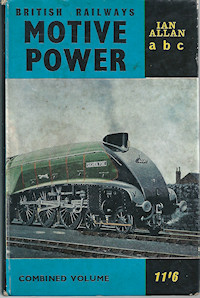
Some of the early editions have recently been reprinted but this is an original 1963 edition. A few colour pictures (paintings rather than photos) were included.
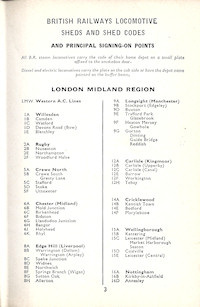
The book usually started with a list of engine sheds and codes, slightly ironic since individual allocations were not shown in the Combined Volume until many years later.

With a few exceptions, stock was listed in numerical order, batches being headed by technical data, and some individual variations shown with symbols.
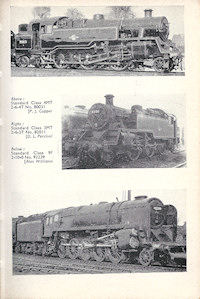
Lots of smallish but good quality, black and white photos were included in each edition.
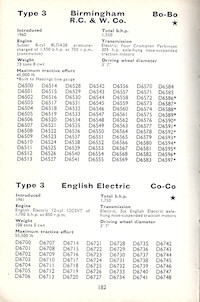
This is a page of diesel loco numbers. The star symbols are the coupling (multiple-working) codes.
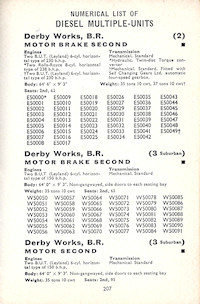
DMU vehicles were listed individually, as the formations were not fixed. Coupling code symbols were again shown, as were regional allocation prefixes.
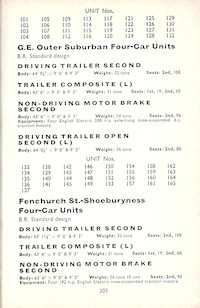
Electric locos were grouped with electric units. The characteristics of the coaches of the latter were given but the listings were confined to just the set numbers.
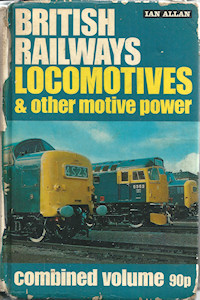
The 1973 edition had a revised title but inside was very similar in format to earlier editions.
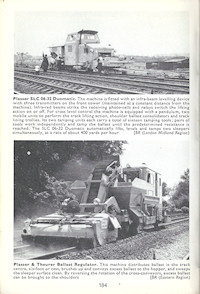
An unusual feature in this edition was the inclusion of a selection of photos of track machines. Numbers were not listed but the function of each machine was outlined.
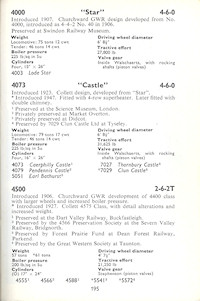
The growing number of preserved steam locos were now listed, with reversed footnotes used to give location information.
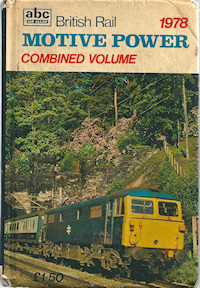
A rather worn copy of the 1978 Combined Volume.
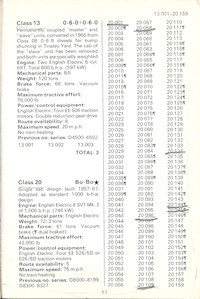
A two-column layout was now standard, with technical information followed by numerical listings, with some individual variations shown using symbols.
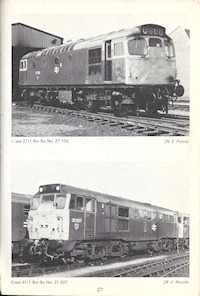
The photos were normally excellent, though the captions gave no extra information (such as when or where the photo was taken). I have just noticed that this page erroneously shows the class 31 as being a Bo-Bo! It was correctly listed as an A1A-A1A elsewhere.
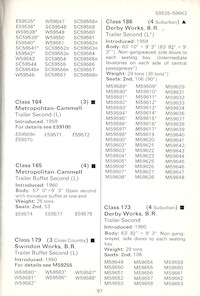
DMU vehicles were listed individually, with references to avoid repetition of technical information. The symbol in the top right of each batch is the coupling compatability code.
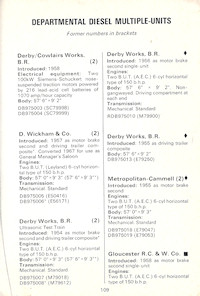
Departmental units were included, with former numbers shown.
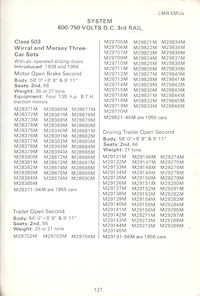
As with earlier editions, multiple units without fixed set numbers had to have all the car numbers listed.
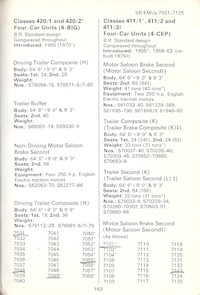
Multiple units with set numbers were still listed just with the set number, though references to the side numbers of the constituent coaches were now included to the technical data.
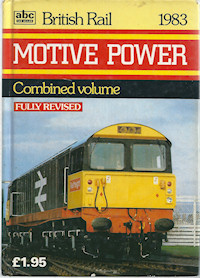
The long-established A6 size was ditched from 1983 in favour of a slightly larger 7in x 5in format.
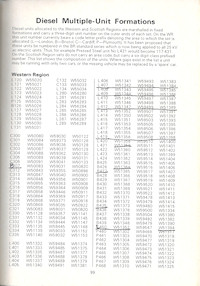
First-generation DMUs were still listed as individual vehicles, though tables showing the formations of Western (and later Scottish) Region units were added.
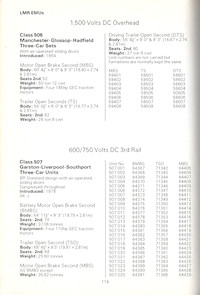
The larger size was put to use to allow the side numbers of coaches within numbered units to be included.
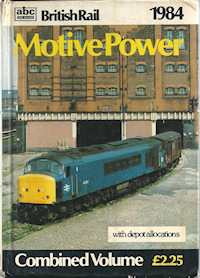
The 1984 edition continued at the larger size, the headline change being the inclusion of depot allocations for the first time.
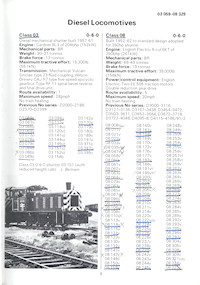
But you won't find any allocation information here! This used copy shows how most people's books would end up.
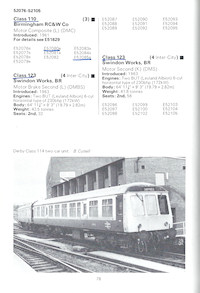
No allocations here either. Photos were spread throughout the book, usually with minimal information in the captions.
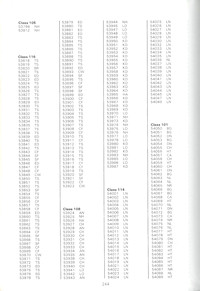
The allocations were actually shown by adding the pages of that year's locoshed book into the back. So, everything was actually listed twice.
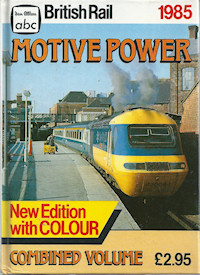
More changes came in 1985. The size was reduced to a little larger than A5, and colour was included.
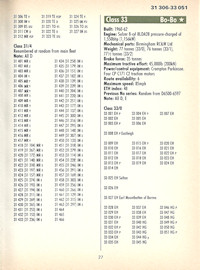
Allocation information was now included in the main part of the book. Less welcome changes were the very condensed font used, and also the cheap paper, which discoloured very quickly.
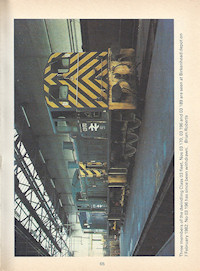
'With Colour' shouted the cover, but there were only 8 colour photos, most still being black and white. Strangely only the colour photos had captions with anything but the barest detail.
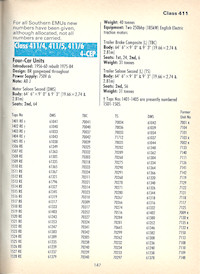
There was a bit of colour on most pages, boxing the class headings! This page shows how some EMUs could not be squeezed into the two-column layout and hence ended up rather spaced out.

Preserved locomotives still featured.
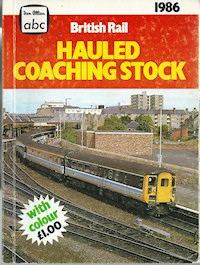
Separate 'pocket' books were still produced and from 1986 there was also one covering coaching stock. I don't know if this was included in that year's Combined Volume.
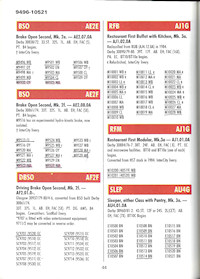
The format was familiar, and although the paper quality seemed to have improved, the condensed font was still being used.
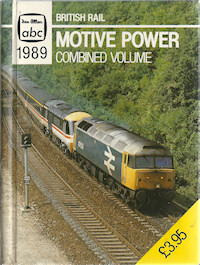
As far as I can tell, the 1989 Combined Volume was the last that Ian Allan published.
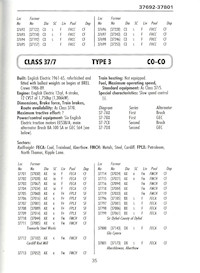
Compared to earlier editions, this one had a lot of detail. As well as technical variations and allocation, sector and livery codes, diagram/design codes were shown for each item.
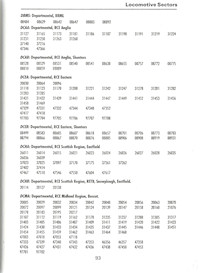
An appendix at the end of the locos section listed all the sector codes, showing all the loco numbers allocated to each.
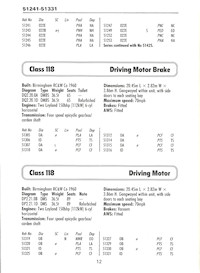
DMU vehicles also had individual diagram numbers. In most cases these were shown in abbreviated form, for example 0A and 1D for DQ2.20.0A and DQ2.20.1D respectively.
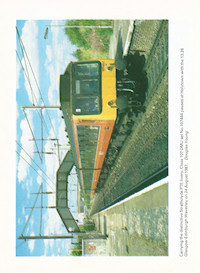
Though mainly in colour, a few of the 52 photos suffered from poor registration in the printing, as seen with this blurry DMU
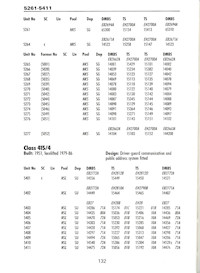
The multiple unit sections used various methods to allow the diagram of each individual coach to be included.
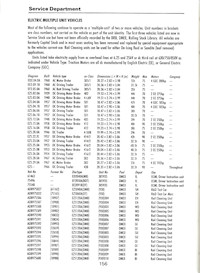
The inclusion of full diagram numbers (referred to as design codes on this website) extended to departmental multiple unit. Set numbers were also shown, but not the actual formations.
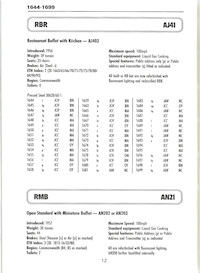
For some reason, coaches did not get full design codes, just the diagram numbers. For example 1644 was to diagram AJ403 but would have had a design code of AJ4030A (or similar).
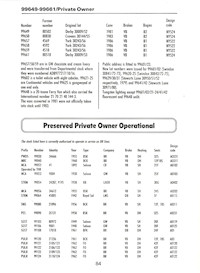
The same applied to privately owned coaches, although curiously the short codes (eg AO231) were referred to as Design Codes rather than Diagrams. My understanding is that the opposite is more correct.
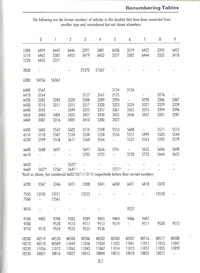
Most renumbered coaches did not have the former identity shown in the main section. Instead a tabulated appendix was included at the back. | 
 Register
Register

 Some of the early editions have recently been reprinted but this is an original 1963 edition. A few colour pictures (paintings rather than photos) were included.
Some of the early editions have recently been reprinted but this is an original 1963 edition. A few colour pictures (paintings rather than photos) were included. The book usually started with a list of engine sheds and codes, slightly ironic since individual allocations were not shown in the Combined Volume until many years later.
The book usually started with a list of engine sheds and codes, slightly ironic since individual allocations were not shown in the Combined Volume until many years later. With a few exceptions, stock was listed in numerical order, batches being headed by technical data, and some individual variations shown with symbols.
With a few exceptions, stock was listed in numerical order, batches being headed by technical data, and some individual variations shown with symbols. DMU vehicles were listed individually, as the formations were not fixed. Coupling code symbols were again shown, as were regional allocation prefixes.
DMU vehicles were listed individually, as the formations were not fixed. Coupling code symbols were again shown, as were regional allocation prefixes. Electric locos were grouped with electric units. The characteristics of the coaches of the latter were given but the listings were confined to just the set numbers.
Electric locos were grouped with electric units. The characteristics of the coaches of the latter were given but the listings were confined to just the set numbers. An unusual feature in this edition was the inclusion of a selection of photos of track machines. Numbers were not listed but the function of each machine was outlined.
An unusual feature in this edition was the inclusion of a selection of photos of track machines. Numbers were not listed but the function of each machine was outlined. The growing number of preserved steam locos were now listed, with reversed footnotes used to give location information.
The growing number of preserved steam locos were now listed, with reversed footnotes used to give location information. A two-column layout was now standard, with technical information followed by numerical listings, with some individual variations shown using symbols.
A two-column layout was now standard, with technical information followed by numerical listings, with some individual variations shown using symbols. The photos were normally excellent, though the captions gave no extra information (such as when or where the photo was taken). I have just noticed that this page erroneously shows the class 31 as being a Bo-Bo! It was correctly listed as an A1A-A1A elsewhere.
The photos were normally excellent, though the captions gave no extra information (such as when or where the photo was taken). I have just noticed that this page erroneously shows the class 31 as being a Bo-Bo! It was correctly listed as an A1A-A1A elsewhere. DMU vehicles were listed individually, with references to avoid repetition of technical information. The symbol in the top right of each batch is the coupling compatability code.
DMU vehicles were listed individually, with references to avoid repetition of technical information. The symbol in the top right of each batch is the coupling compatability code. As with earlier editions, multiple units without fixed set numbers had to have all the car numbers listed.
As with earlier editions, multiple units without fixed set numbers had to have all the car numbers listed. Multiple units with set numbers were still listed just with the set number, though references to the side numbers of the constituent coaches were now included to the technical data.
Multiple units with set numbers were still listed just with the set number, though references to the side numbers of the constituent coaches were now included to the technical data. First-generation DMUs were still listed as individual vehicles, though tables showing the formations of Western (and later Scottish) Region units were added.
First-generation DMUs were still listed as individual vehicles, though tables showing the formations of Western (and later Scottish) Region units were added. The larger size was put to use to allow the side numbers of coaches within numbered units to be included.
The larger size was put to use to allow the side numbers of coaches within numbered units to be included. The 1984 edition continued at the larger size, the headline change being the inclusion of depot allocations for the first time.
The 1984 edition continued at the larger size, the headline change being the inclusion of depot allocations for the first time. But you won't find any allocation information here! This used copy shows how most people's books would end up.
But you won't find any allocation information here! This used copy shows how most people's books would end up. No allocations here either. Photos were spread throughout the book, usually with minimal information in the captions.
No allocations here either. Photos were spread throughout the book, usually with minimal information in the captions. The allocations were actually shown by adding the pages of that year's locoshed book into the back. So, everything was actually listed twice.
The allocations were actually shown by adding the pages of that year's locoshed book into the back. So, everything was actually listed twice. More changes came in 1985. The size was reduced to a little larger than A5, and colour was included.
More changes came in 1985. The size was reduced to a little larger than A5, and colour was included. Allocation information was now included in the main part of the book. Less welcome changes were the very condensed font used, and also the cheap paper, which discoloured very quickly.
Allocation information was now included in the main part of the book. Less welcome changes were the very condensed font used, and also the cheap paper, which discoloured very quickly. 'With Colour' shouted the cover, but there were only 8 colour photos, most still being black and white. Strangely only the colour photos had captions with anything but the barest detail.
'With Colour' shouted the cover, but there were only 8 colour photos, most still being black and white. Strangely only the colour photos had captions with anything but the barest detail. There was a bit of colour on most pages, boxing the class headings! This page shows how some EMUs could not be squeezed into the two-column layout and hence ended up rather spaced out.
There was a bit of colour on most pages, boxing the class headings! This page shows how some EMUs could not be squeezed into the two-column layout and hence ended up rather spaced out. Separate 'pocket' books were still produced and from 1986 there was also one covering coaching stock. I don't know if this was included in that year's Combined Volume.
Separate 'pocket' books were still produced and from 1986 there was also one covering coaching stock. I don't know if this was included in that year's Combined Volume. The format was familiar, and although the paper quality seemed to have improved, the condensed font was still being used.
The format was familiar, and although the paper quality seemed to have improved, the condensed font was still being used. Compared to earlier editions, this one had a lot of detail. As well as technical variations and allocation, sector and livery codes, diagram/design codes were shown for each item.
Compared to earlier editions, this one had a lot of detail. As well as technical variations and allocation, sector and livery codes, diagram/design codes were shown for each item. An appendix at the end of the locos section listed all the sector codes, showing all the loco numbers allocated to each.
An appendix at the end of the locos section listed all the sector codes, showing all the loco numbers allocated to each. DMU vehicles also had individual diagram numbers. In most cases these were shown in abbreviated form, for example 0A and 1D for DQ2.20.0A and DQ2.20.1D respectively.
DMU vehicles also had individual diagram numbers. In most cases these were shown in abbreviated form, for example 0A and 1D for DQ2.20.0A and DQ2.20.1D respectively. Though mainly in colour, a few of the 52 photos suffered from poor registration in the printing, as seen with this blurry DMU
Though mainly in colour, a few of the 52 photos suffered from poor registration in the printing, as seen with this blurry DMU The multiple unit sections used various methods to allow the diagram of each individual coach to be included.
The multiple unit sections used various methods to allow the diagram of each individual coach to be included. The inclusion of full diagram numbers (referred to as design codes on this website) extended to departmental multiple unit. Set numbers were also shown, but not the actual formations.
The inclusion of full diagram numbers (referred to as design codes on this website) extended to departmental multiple unit. Set numbers were also shown, but not the actual formations. For some reason, coaches did not get full design codes, just the diagram numbers. For example 1644 was to diagram AJ403 but would have had a design code of AJ4030A (or similar).
For some reason, coaches did not get full design codes, just the diagram numbers. For example 1644 was to diagram AJ403 but would have had a design code of AJ4030A (or similar).